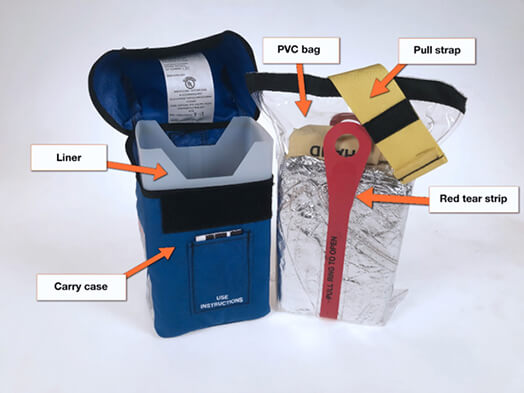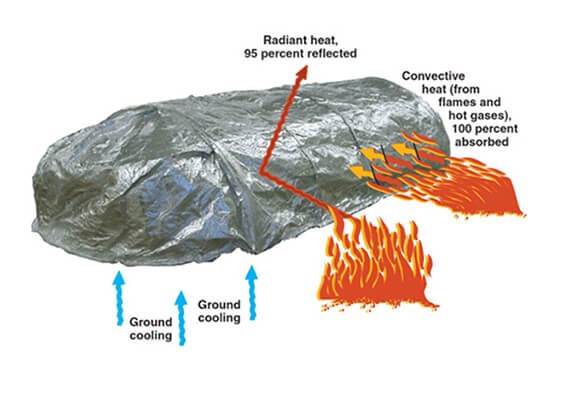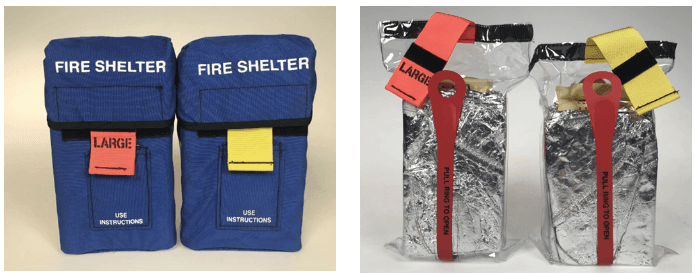In the challenging world of wildland firefighting, where every decision can mean the difference between safety and peril, fire shelters emerge as indispensable tools in the arsenal of wildland firefighters. Understanding the nuances of fire shelter design, deployment, and limitations is essential for safeguarding the lives of those who bravely confront the relentless fury of wildfires. This guide to fire shelters helps to provide wildland firefighters with the knowledge necessary to navigate the complexities of fire shelter usage effectively.
The Anatomy of Fire Shelters
Crafted with precision to withstand the searing heat and flames of wildfires, fire shelters consist of two layers meticulously designed to combat radiant and convective heat. The outer layer, constructed from aluminum foil bonded to woven silica, reflects up to 95% of radiant heat while impeding the transfer of heat to the shelter’s interior. Meanwhile, the inner layer, composed of aluminum foil laminated to fiberglass, acts as a barrier against heat reradiation, providing additional insulation to shield occupants from the inferno’s onslaught. An air gap strategically integrated between these layers enhances insulation, creating a survivable environment within the shelter.

Utilizing Fire Shelters in the Field
When deployed as a last resort, wildland firefighters must lie face-down inside the shelter, minimizing exposure to radiant and convective heat. Swift and decisive action is paramount, requiring rapid deployment even amidst the most challenging conditions. Realizing the potential lifesaving capabilities of fire shelters hinges on thorough training, ensuring that wildland firefighters are proficient in navigating the intricacies of shelter deployment amidst the chaos of the fire line.

Fire Shelter Sizes
Selecting the right-sized fire shelter is critical for wildland firefighters operating in diverse environments and facing varying levels of risk. With options available in regular size and large size, it is essential to choose a shelter that provides optimal protection while accommodating individual body types and preferences. The large shelter, particularly, offers enhanced insulation for taller or larger wildland firefighters, fortifying their defenses against the relentless advance of the flames.

Addressing Limitations and Considerations
While fire shelters offer a vital lifeline in the face of danger, it is crucial for wildland firefighters to recognize their limitations. Shelters are a last resort and should never replace safe firefighting practices or strategic risk mitigation strategies. Prolonged exposure to direct flames or conductive heat can compromise shelter integrity, underscoring the importance of proactive training and continuous readiness.
Conclusion: Safeguarding Lives Amidst the Flames
In the dynamic world of wildland firefighting, where uncertainty reigns supreme and danger lurks at every turn, fire shelters stand as beacons of hope—a symbol of resilience in the face of adversity. Through rigorous training, meticulous preparation, and unwavering commitment to safety, wildland firefighters can harness the lifesaving potential of fire shelters, preserving lives and protecting communities amidst the relentless fury of wildfires. As stewards of the wildlands, wildland firefighters must remain vigilant, continuously honing their skills and embracing innovation to confront the ever-evolving challenges of the modern firefighting landscape.
Sources:
https://www.nwcg.gov/publications/pms411/know-your-fire-shelter
https://abcnews.go.com/US/freight-train-firefighters-describe-riding-blaze-fire-shelter/story?id=73420186

